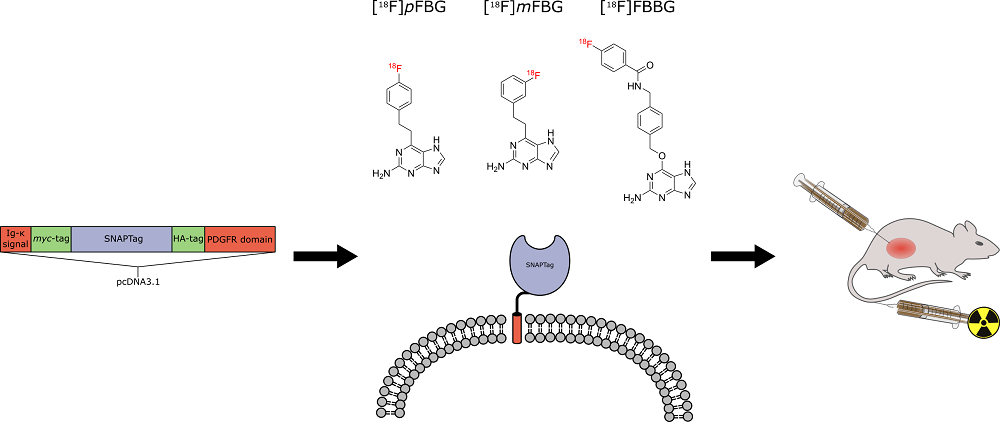There is a need for versatile in vivo nuclear imaging reporter systems to foster preclinical and clinical research. We explore the applicability of the SNAPTag and novel radiolabeled small-molecule ligands as a versatile reporter gene system for in vivo nuclear imaging. SNAPTag is a high-affinity protein tag used in a variety of biochemical research areas and based on the suicide DNA repair enzyme O6-methylguanine methyl transferase (MGMT). Its ligands are well suited for reporter gene imaging as the benzyl guanine core scaffold can be derivatized with fluorescent or radiolabeled moieties for various applications. Three guanine-based SNAPTag ligands ([18F]FBBG, [18F]pFBG and [18F]mFBG) were synthesized in high yields and were (radio)chemically characterized. HEK293 cells were engineered to express the SNAPTag on the cell surface and served as cell model to assess target affinity by radiotracer uptake assays, Western blotting and SDS-PAGE autoradiography. A subcutaneous HEK293-SNAPTag xenograft model in immunodeficient mice was used for in vivo evaluation of [18F]FBBG amd [18F]pFBG while the biodistribution of [18F]mFBG was characterized in naïve animals. The results were validated by ex vivo biodistribution studies and immunofluorescence staining of the xenografts. All three radiotracers were produced in high radiochemical purity, molar activity and good yields. Western blot analysis revealed successful SNAPTag expression by the transfected HEK293 cells. In vitro testing revealed high target affinity of all three tracers with an up to 191-fold higher signal in the HEK293-SNAPTag cells compared to untransfected cells. This was further supported by a prominent radioactive protein band at the expected size in the SDS-PAGE autoradiograph of cells incubated with [18F]FBBG or [18F]pFBG. The in vivo studies demonstrated high uptake in HEK293-SNAP xenografts compared to HEK293 xenografts with excellent tumor-to-muscle ratios (7.5 ± 4.2 for [18F]FBBG and 10.6 ± 6.2 for [18F]pFBG). In contrast to [18F]pFBG and its chemical analogue [18F]mFBG, [18F]FBBG showed no signs of unspecific bone uptake and defluorination in vivo. Radiolabeled SNAPTag ligands bear great potential for clinical applications such as in vivo tracking of cell populations, antibody fragments and targeted radiotherapy. With excellent target affinity, good stability, and low non-specific binding, [18F]FBBG is a highly promising candidate for further preclinical evaluation.

